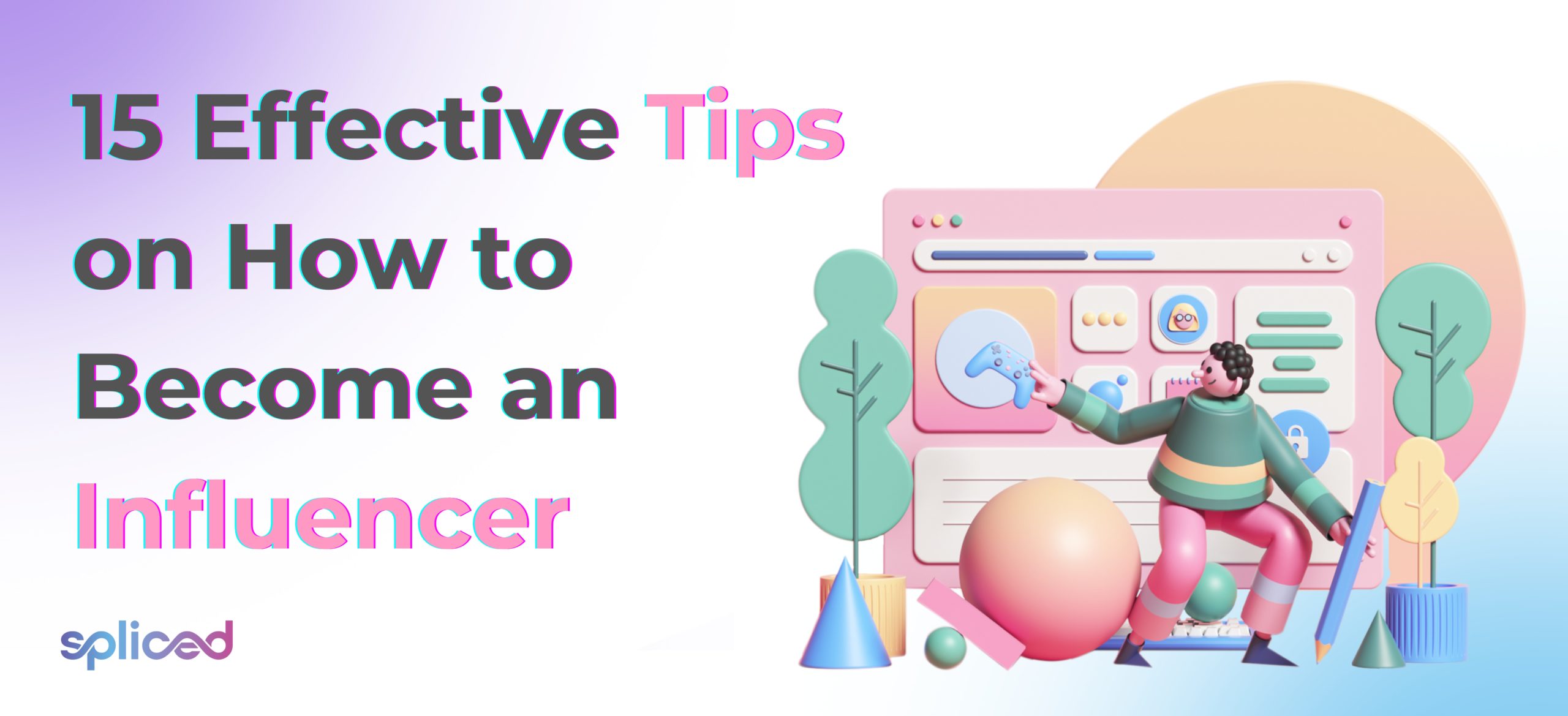Influencer refers to a person who has gained recognition and trustworthiness in a certain field or specialized area, enabling them to exert influence over the perspectives and actions of their followers. Influence is generally developed through the utilization of social media or other digital platforms.
Influencers make money in many ways, such as through paid content, working with brands, affiliate marketing, endorsing products, and sometimes even starting their own lines of products. Long-term success as an influencer depends heavily on the individual’s capacity to keep up with shifting industry standards, keep their audience interested, and diversify their revenue streams.
Being an influencer comes with a number of benefits, some of which include a more adaptable work schedule, the ability to collaborate with a wide range of brands, the liberty to freely express their creativity, and a chance at receiving substantial financial compensation. The satisfaction that comes from influencing others, setting trends, and building communities of people who care about is a major motivating factor for many influencers.
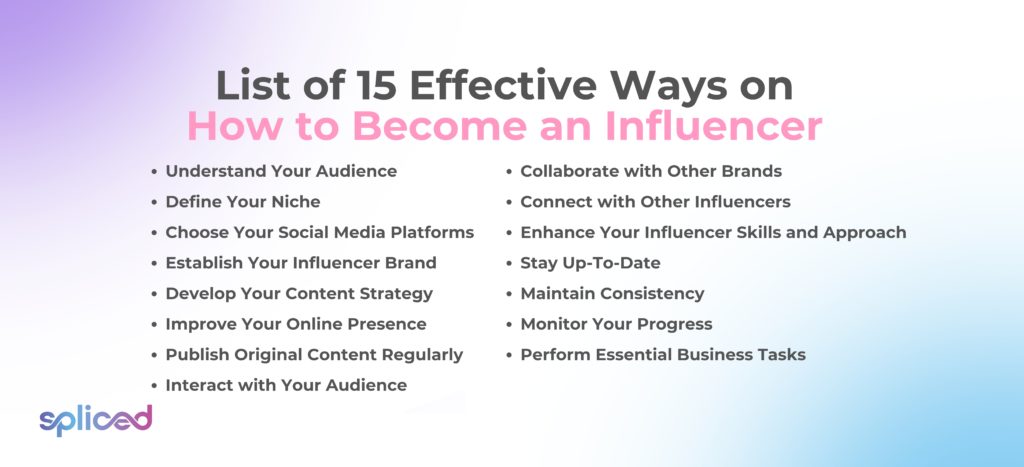
The 15 effective tips on how to become an influencer are listed below.
- Understand Your Audience: It is essential to have a solid understanding of who the audience is and what they are looking for. Creating content that speaks to their interests and wants is a crucial first step in developing a devoted audience.
- Define Your Niche: The process of identifying and establishing a distinct and specialized area of interest contributes to the development of targeted content and the attraction of a committed audience. Differentiating oneself from others and working with them more specifically is made achievable by it.
- Choose Your Social Media Platforms: Different platforms serve different target audiences. Reaching out to the appropriate people means picking the proper channels where they spend their time online.
- Establish Your Influencer Brand: The personal brand of an individual serves as their own identity. The development of a distinctive and genuine brand contributes to the establishment of a lasting impact and the cultivation of confidence among one’s target demographic.
- Develop Your Content Strategy: An effectively designed content strategy guarantees the maintenance of consistency and relevancy. It involves choosing the kind of material to post, how frequently to post, and interaction strategies.
- Improve Your Online Presence: Improving one’s online presence across many channels has the potential to increase exposure and expand reach. The process includes the optimization of profiles and active engagement with the community.
- Publish Original Content Regularly: Consistently releasing unique content boosts audience engagement and allows one to stay visible on sites that rely on algorithms.
- Interact with Your Audience: Establishing a connection with one’s audience through active engagement serves to enhance levels of participation and foster a sense of loyalty. Engaging with comments and messages adds a personalized touch to the overall user experience.
- Collaborate with Other Brands: Collaborations are a great way to broaden viewers and give credibility to the work. It is crucial to select companies that fit the niche and ideals.
- Connect with Other Influencers: Engaging in peer networking offers valuable learning prospects and new collaborations, broadening one’s area of influence.
- Enhance Your Influencer Skills and Approach: The consistent enhancement of skills such as communication, photography, and marketing has the potential to enhance the caliber of one’s content and approach.
- Stay Up-To-Date: Staying informed about current trends and algorithmic modifications is crucial for adjusting content strategies and ensuring continued relevance.
- Maintain Consistency: The establishment of consistency in both content and message contributes to the cultivation of a dependable and competent image, building trust and loyalty among the audience.
- Monitor Your Progress: The use of measures such as engagement, reach, and growth improves the comprehension of effective strategies and areas requiring enhancement.
- Perform Essential Business Tasks: Dealing with business issues like contract negotiations, money management, and legal issues is important for an influencer job that lasts.
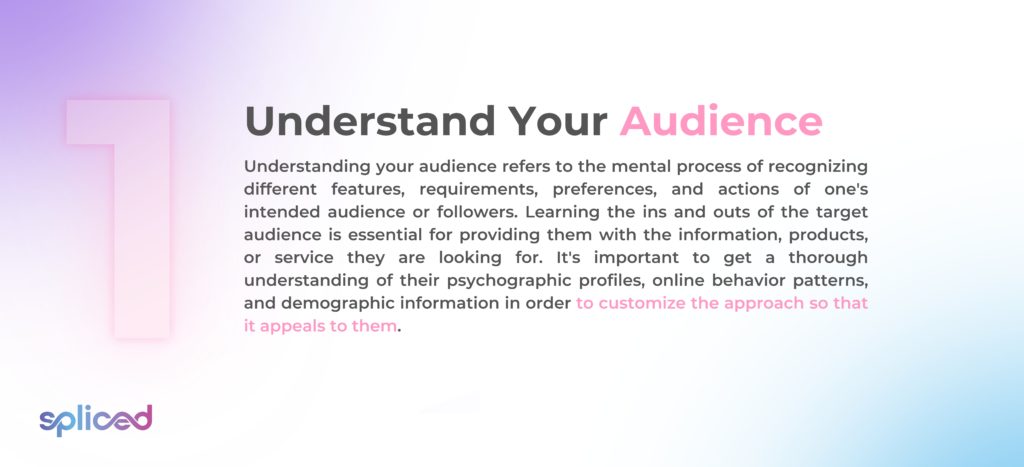
1. Understand Your Audience
Understanding your audience refers to the mental process of recognizing different features, requirements, preferences, and actions of one’s intended audience or followers. Learning the ins and outs of the target audience is essential for providing them with the information, products, or service they are looking for. It’s important to get a thorough understanding of their psychographic profiles, online behavior patterns, and demographic information in order to customize the approach so that it appeals to them.
Effective marketing and communication strategies are built around understanding the audience. Understanding the audience allows influencers to develop more relevant and compelling content for them. Understanding the audience helps people connect with each other better and feel like they are part of a group. Understanding the target market helps in designing products and services that are more likely to win over and retain customers. Understanding one’s target audience is a fundamental requirement for the prosperity of a business or personal brand within a highly competitive context.
The process of understanding one’s audience is a dynamic effort that includes the collection and analysis of facts pertaining to them. Multiple sources, including social media analytics, website traffic analysis, and direct response from surveys or comments, provide such information. It involves looking at psychographic elements like hobbies, values, and lifestyles in addition to demographic data like age, gender, and geography. The data collected is then used to construct a thorough understanding of the target audience, enabling content providers or corporations to customize their strategies and communications in a way that is more effective.
There are many advantages associated with having a comprehensive awareness of one’s audience. Understanding the audience lets people make material that is more relevant and interesting, which makes audiences happier and more involved. Another benefit of understanding the audience additionally allows for enhanced precision in marketing campaigns, significantly increasing return on investment. More loyalty and trust are generated since it creates a stronger bond between the influencer or brand and their audience.
Understanding the audience presents its own set of difficulties. The process is going to take a lot of time and resources, and it takes constant work to gather and analyze data. Another risk is over-specialization, which occurs when one becomes overly focused on a certain target segment, limiting one’s ability to reach a wider market. Another disadvantage is the preferences of an audience. It shifts quickly, necessitating regular adjustments, and there are privacy issues to think about while collecting that data.
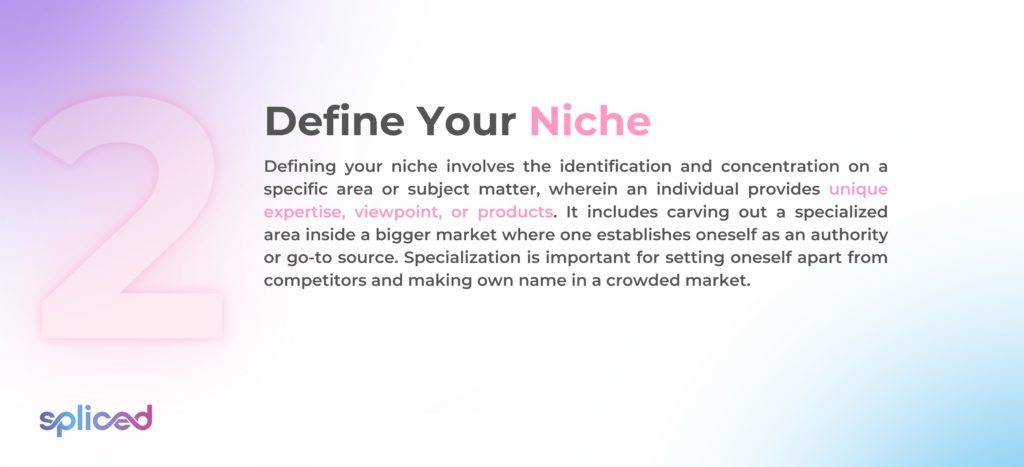
2. Define Your Niche
Defining your niche involves the identification and concentration on a specific area or subject matter, wherein an individual provides unique expertise, viewpoint, or products. It includes carving out a specialized area inside a bigger market where one establishes oneself as an authority or go-to source. Specialization is important for setting oneself apart from competitors and making own name in a crowded market.
The importance of defining the niche lies in the capacity to differentiate oneself within a progressively saturated market. Targeting a certain niche allows one to better cater to the specific requirements of that audience and satisfy their preferences. Specialization helps build a more loyal and interested audience, since people often look for material or products that are just right for them. Having a clearly defined niche allows to target a specific audience more precisely, which increases the effectiveness and efficiency of the marketing efforts.
Consider the hobbies, areas of skill, and the needs of consumers to determine the niche. The process involves carrying out research to uncover potential market gaps, comprehending the strategies used by competitors, and recognizing opportunities to provide exceptional or better offerings. It is simpler to adjust the branding, content, and marketing tactics to fit the unique traits and requirements of the target audience inside the chosen niche once the niche is determined.
One of the best things about having a clear niche is that it helps to become an acknowledged expert or leader in that field. It helps the audience trust and believe in the influencer more. Knowing exactly who the audience is and what they want helps to market to them more effectively. Niche markets frequently encounter reduced levels of competition compared to bigger markets, presenting increased prospects for expansion and achievement.
Having an extremely exclusive and limited market niche does, however, come with certain drawbacks. The restriction has the ability to constrain the scope of the potential audience and market, potentially limiting the expansion of the brand or business. A shift or adjustment to new trends is necessary if the niche loses popularity or relevance over time. Not to mention that it is difficult to strike a balance between appeal and specialization, particularly in quickly changing markets.
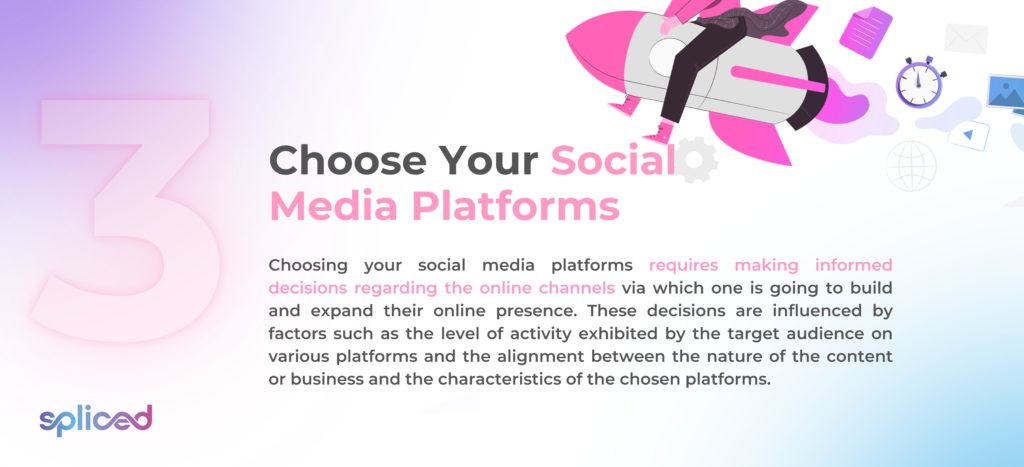
3. Choose Your Social Media Platforms
Choosing your social media platforms requires making informed decisions regarding the online channels via which one is going to build and expand their online presence. These decisions are influenced by factors such as the level of activity exhibited by the target audience on various platforms and the alignment between the nature of the content or business and the characteristics of the chosen platforms. Making the right decision is important because different platforms, like the visually stimulating Instagram, the conversation-focused Twitter, or the business networking site LinkedIn, serve distinct populations, behaviors, and content formats.
The importance of choosing the right social media is not to be overlooked within a digital environment characterized by an overwhelming number of various choices. The decision made about the allocation of time and resources has an important impact on the efficacy of one’s online presence. The more platforms to choose, the more likely it is that the audience is going to engage with it, develop a devoted following, and meet the digital marketing objectives.
Understanding the target audience and figuring out where they spend their time online is the first step in the process. The process includes looking at the demographic characteristics, user behavioral patterns, and popular content types on each platform. It must take into account the nature of the information generated, such as videos, articles, and imagery, as well as the level of interaction facilitated by each platform. The customized strategy guarantees that influencers are not spreading their efforts too thin across various platforms but rather focusing on the ones that deliver the best return for their particular aims.
Choosing the right social media sites lets influencers target and interact with the community more effectively. Higher engagement rates are achieved by using it to provide content that appeals to the platform’s user base. The use of a focused approach additionally results in time and resource savings, as it allows for the concentration of efforts on platforms that demonstrate the highest efficacy in achieving desired objectives.
Having so many options, however, feels restrictive at times. Concentrating one’s attention to particular platforms results in overlooking potential audiences in other settings. Trends on social media and the success of platforms changes over time, which make the platforms chosen less useful over time. Another risk is relying too much on the social media platforms’ algorithms and policies, which change suddenly and have an effect on the engagement and reach.
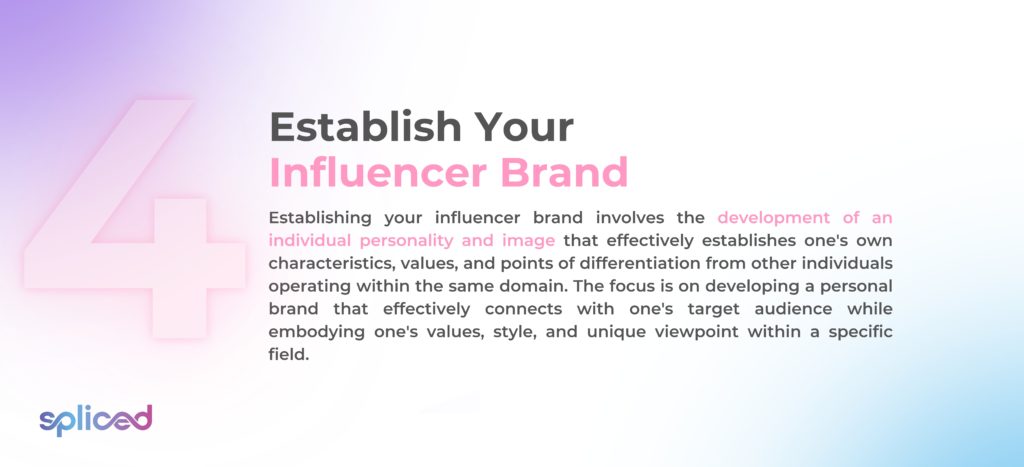
4. Establish Your Influencer Brand
Establishing your influencer brand involves the development of an individual personality and image that effectively establishes one’s own characteristics, values, and points of differentiation from other individuals operating within the same domain. The focus is on developing a personal brand that effectively connects with one’s target audience while embodying one’s values, style, and unique viewpoint within a specific field. The establishment of a brand serves as a unique portrayal that shapes one’s self-presentation across multiple platforms and in engagements with their audience and partners.
The importance of establishing a strong influencer brand is in its capacity to make an enduring impact on one’s audience and potential partners. Credibility and trust are increased with a clearly defined brand. Enhancing one’s recognizability and memorability is a result of differentiating oneself within a highly saturated digital environment. A strong brand directs the development of the content and business choices, guaranteeing coherence and harmony with the primary goals and values.
The process of establishing one’s influencer brand starts with engaging in self-reflection to identify distinctive characteristics, interests, and values. The process involves making thoughtful decisions regarding a cohesive aesthetic, tone of voice, and content themes that align with one’s individuality and resonate with the intended audience. Establishing a brand necessitates maintaining a uniformity in both messaging and presentation across many media,which promotes a consistent and easily identifiable identity.
The establishment of a reputable influencer brand has the potential to result in heightened levels of recognition and loyalty among one’s target audience. It’s useful for drawing in partners who share the brand’s values. A robust brand additionally offers a unique orientation for content generation and business choices, enhancing the concentration and efficacy of the work.
Setting up a brand, on the other hand, is not easy. The development and maintenance of a consistent brand image necessitate an important allocation of time and resources. Another risk is categorizing oneself into a particular persona or style, which makes it harder for one to change or adjust to changing trends. A focus on branding that is too strong takes away from the sincerity and relatability that many people look for in influencers.
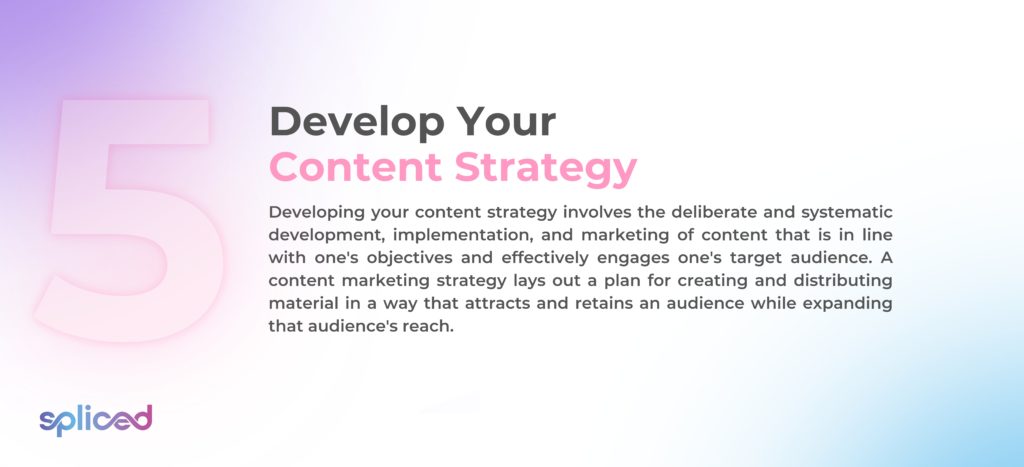
5. Develop Your Content Strategy
Developing your content strategy involves the deliberate and systematic development, implementation, and marketing of content that is in line with one’s objectives and effectively engages one’s target audience. A content marketing strategy lays out a plan for creating and distributing material in a way that attracts and retains an audience while expanding that audience’s reach. It involves choosing the topics, styles, and publishing schedule for the content and figuring out how it increases audience interaction while advancing the main goals.
The importance of a well planned content strategy is in its capacity to offer guidance and concentration to one’s work in content development. It guarantees that the information provided is relevant to the audience’s interests and needs, consistent, and well-purposed. A strong content strategy plays an important part in establishing an integrated company narrative and supporting the attainment of certain objectives, be it audience expansion, enhanced engagement, or generating income. Effective content marketing and audience development rely on it as a fundamental component.
Understanding the audience and establishing specific goals are the first steps in creating a content strategy. The process entails the identification of content categories that effectively engages the target audience and align with the brand’s values and objectives. Selecting topics, publication schedules, and content types (such as blogs, videos, or social media postings) that strike a balance between the demands of the audience and the ability to create high-quality content are all part of the process. The success of the content must be measured and analyzed so that the strategy is improved and changed over time.
A good content plan makes sure that the content is always useful and relevant to the audience, which is able to boost their engagement and loyalty. Concentrating on the most influential content categories facilitates the effective distribution of resources. A clear plan helps create a strong, consistent brand voice across all content, which builds trust and recognition of the brand.
Creating and maintaining a content plan, in contrast, takes a lot of time and resources. Adapting the strategy to evolving audience preferences and digital developments provide a considerable challenge. A strategy that is too rigid makes it harder to be creative and spontaneous when making content, which makes the content feel less real or interesting.
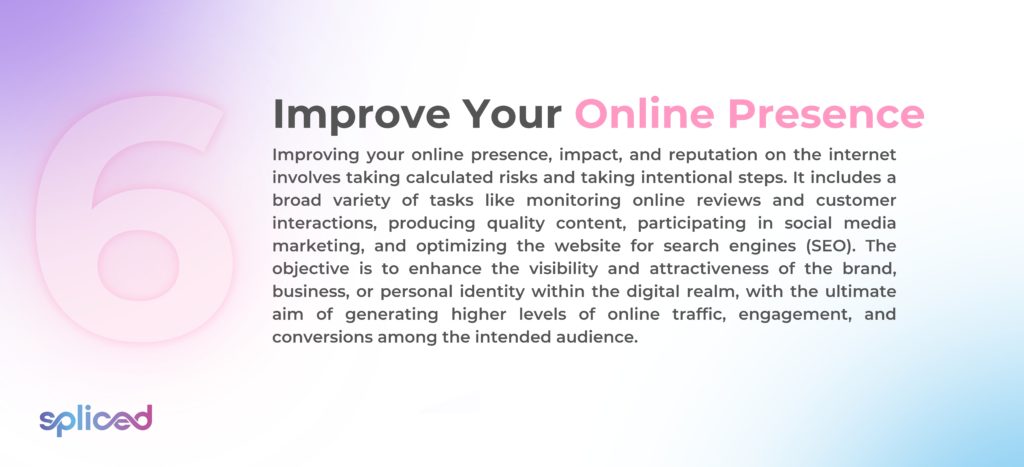
6. Improve Your Online Presence
Improving your online presence, impact, and reputation on the internet involves taking calculated risks and taking intentional steps. It includes a broad variety of tasks like monitoring online reviews and customer interactions, producing quality content, participating in social media marketing, and optimizing the website for search engines (SEO). The objective is to enhance the visibility and attractiveness of the brand, business, or personal identity within the digital realm, with the ultimate aim of generating higher levels of online traffic, engagement, and conversions among the intended audience.
Improving one’s online presence is important in the contemporary digital era, as it profoundly influences an individual’s level of achievement and competition. Having a solid online presence has several advantages, including the ability to extend one’s reach to a wider audience, establish trust and credibility, and maintain a competitive edge over rivals. It enables the development of connections with clients and the gathering of useful feedback, which allows for adaptation and growth within a dynamic online environment.
Creating useful and high-quality content, search engines optimizing the website, interacting with the audience on social media, and keeping an eye on and handling online reviews and mentions are just a few tactics to use to improve the online presence. These collective actions aim to enhance online visibility and reputation, ultimately resulting in increased website traffic, heightened brand recognition, and the generation of leads and sales.
Having a strong online presence is essential for both organizations and individuals in today’s digital age, as consumers rely on the internet for information and purchase decisions. The act of establishing credibility, cultivating trust, and nurturing relationships with one’s audience is beneficial. It serves as a venue for promoting one’s expertise, products, or services, which boosts the chances of success in the virtual marketplace.
There are several advantages associated with improving one’s online presence. These include heightened exposure and extended reach, increased brand awareness, expanded consumer involvement, and an opportunity for increased conversion rates and sales. Better tracking and analysis of the online performance is another benefit, allowing to hone the tactics and make data-driven choices. Having a strong online presence helps in keeping up with the latest digital developments and maintaining the competitive edge.
There are, however, some bad things to think about when trying to improve the online profile. Sometimes it takes a lot of time and money to do, like hiring people and setting aside money for promotion. The management of online interactions and reputation presents a notable challenge due to the heightened visibility of negative feedback and comments. The digital landscape is always shifting, which is why it is vital to keep up with the most recent trends and technology; yet, it is a difficult job that must be done repeatedly.
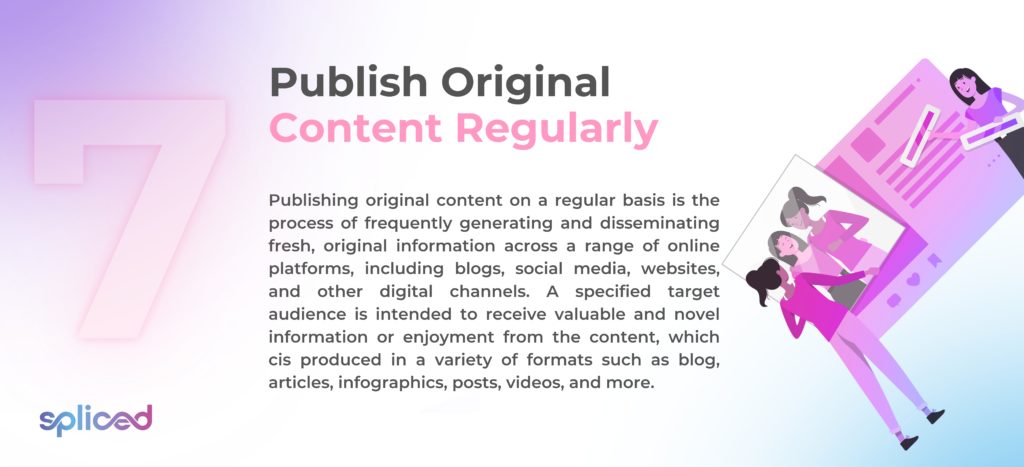
7. Publish Original Content Regularly
Publishing original content on a regular basis is the process of frequently generating and disseminating fresh, original information across a range of online platforms, including blogs, social media, websites, and other digital channels. A specified target audience is intended to receive valuable and novel information or enjoyment from the content, which cis produced in a variety of formats such as blog, articles, infographics, posts, videos, and more. A regular timetable for content development and distribution is essential to the strategy since it guarantees that the audience always has access to interesting and new stuff.
Regularly creating and distributing original content is crucial. Other factors to consider include the content’s originality and relevance, as well as the platforms on which it is distributed. Maintaining a regular schedule and producing content that appeals to the target audience are essential. The goal of the method is to build trustworthiness, authority, and a loyal following in a certain niche or industry by consistently giving the audience useful information, solutions, or fun things to do.
The consistent publication of unique content necessitates a methodical approach encompassing various stages, including content strategizing, generation, improvement, and marketing. The process starts by conducting research on the interests and demands of the target audience, followed by the identification of appropriate topics and the formulation of content ideas. The next step involves creating content, which is then edited and optimized for social media and search engines. It applies to written articles, videos, podcasts, or other formats. The last step is to post the content on the right platforms and promote it so it reaches the right people.
The importance of consistently generating unique information is in its capacity to generate diverse advantages. The use of online platforms helps in the establishment and maintenance of a digital presence, fostering credibility and confidence within a certain domain, while enabling interaction with a designated audience. Consistent publication of contents enhances search engine optimization (SEO), as search engines reward websites with updated content. It helps influencers stay at the forefront of the audience’s minds, promotes loyalty and return visits, and results in higher website traffic, greater conversion rates, and better brand awareness.
Regularly releasing unique content has several advantages, such as better search engine rankings, more online visibility, enhanced audience engagement, and the ability to draw in and hold on to an engaged audience. Another way to make money with it is through ads, affiliate marketing, or selling goods and services. Producing high-quality content on a regular basis helps maintain a competitive edge in the market or business.
Disadvantages must be taken into account when releasing fresh content on a regular basis. Maintaining a regular flow of content necessitates an important amount of time, consistent work, and creative thinking. Finding fresh and pertinent subjects or ideas is difficult, and the pressure to create content on time results in burnout or a drop in the standard of the work. Furthermore, it is important to note that not every content has the ability to resonate effectively with the intended audience. It is important to acknowledge that achieving significant results in terms of increased traffic or conversions needs a considerable amount of time.
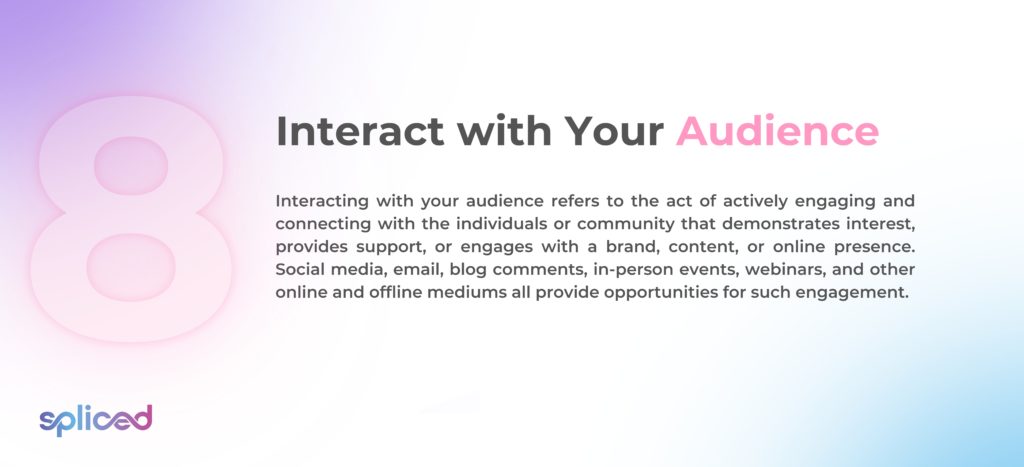
8. Interact with Your Audience
Interacting with your audience refers to the act of actively engaging and connecting with the individuals or community that demonstrates interest, provides support, or engages with a brand, content, or online presence. Social media, email, blog comments, in-person events, webinars, and other online and offline mediums all provide opportunities for such engagement. It includes responding to queries, comments, and feedback in addition to proactively striking up discussions and building a feeling of community and connection with the audience.
The most significant aspects of engaging with the audience are participating actively in conversations, answering questions and comments in a timely and meaningful manner, and offering helpful advice or information. The process of communication is bilateral in nature, with the objective of establishing a positive relationship, fostering trust, and cultivating loyalty with the intended recipients, all the while acquiring valuable knowledge about their requirements and preferences.
Engaging with one’s audience frequently involves the monitoring and administration of diverse communication channels. The process starts with the active engagement of attentively listening to the discourse put forth by one’s audience, encompassing expressions of commendation, critique, inquiries, or recommendations. The next step is to respond, interact, and initiate conversations with the goal of addressing problems, offering information, or simply expressing gratitude for their support. The objective is to establish a constructive and interactive digital presence that fosters continuous participation and discourse.
The importance of engaging with one’s audience is in its capacity for creating an inclusive environment and establishing connections. Establishing trust and credibility is crucial, since audiences tend to value brands and individuals who exhibit approachability and responsiveness. Efficient communication additionally allows the collection of useful feedback, enabling the customization of content or products to more effectively align with the requirements of the target audience. Audiences that are interested and fulfilled are more likely to become devoted followers, promoters, or clients, which are going to advance the growth and success of the website or business.
The advantages of engaging with one’s audience include the development of solid connections and loyalty, the gathering of useful insights for enhancement, the promotion of a favorable brand image, and increased levels of engagement and interaction on one’s content or platform. Increased word-of-mouth advertising is another benefit, since happy customers are more inclined to tell others about the company or product.
It’s important to weigh the pros and downsides of audience interaction before diving in. Maintaining the success of social media needs constant and sincere interaction, which may be time-consuming, especially if one has a large and engaged following. Managing negative feedback or criticism poses obstacles, as does meeting the expectations of all members of one’s audience.
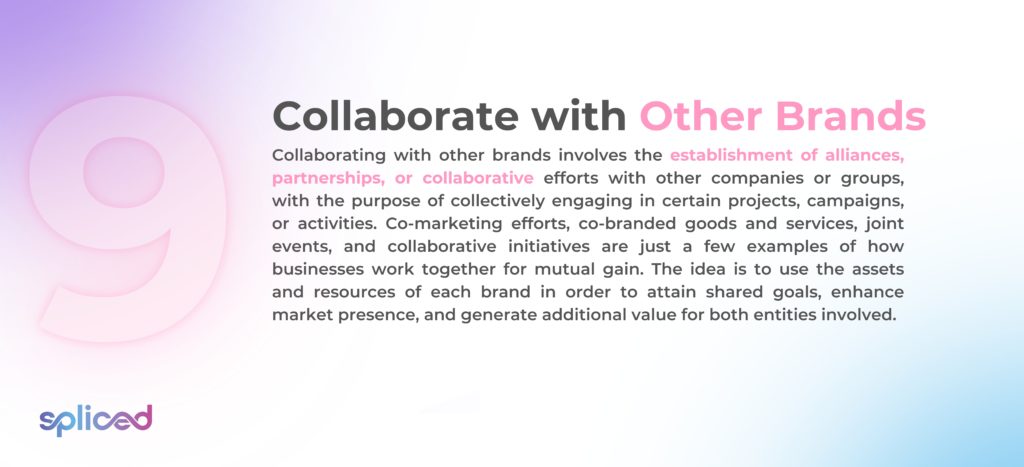
9. Collaborate with Other Brands
Collaborating with other brands involves the establishment of alliances, partnerships, or collaborative efforts with other companies or groups, with the purpose of collectively engaging in certain projects, campaigns, or activities. Co-marketing efforts, co-branded goods and services, joint events, and collaborative initiatives are just a few examples of how businesses work together for mutual gain. The idea is to use the assets and resources of each brand in order to attain shared goals, enhance market presence, and generate additional value for both entities involved.
The key aspects of engaging in collaborative efforts with other brands encompass effective communication, alignment of objectives, mutual advantages, and a precisely specified scope of the collaborative effort. The process often involves the identification of mutually beneficial interactions through the recognition of complementary skills, experience, or client bases among the participating brands.
The process of engaging in collaborative ventures with other brands often starts by identifying prospective partners and subsequently forming a mutually advantageous agreement or partnership. Negotiations, clarifying roles and responsibilities, establishing goals, and laying out the framework for the partnership are all essential steps. The two brands collaborate to carry out the planned projects, utilizing their combined assets and knowledge to accomplish their common objectives after the agreement is established.
The importance of engaging in collaborating with other brands rests in its capacity to ease the exploration of fresh prospects, expand the reach to wider audiences, and enhance the efficiency in attaining shared objectives. It enables brands to take advantage of one another’s assets and strengths, which boost revenue creation, customer acquisition, and brand visibility. Collaborating with other brands have the potential to cultivate creativity and innovation by combining diverse viewpoints and specialized knowledge to address challenges or generate innovative products or experiences.
The advantages of collaborating with other brands include the broadening of one’s market reach and visibility, the opportunity to tap into untapped client groups, the pooling of resources and experience, the potential for cost-sharing, and the potential of enhancing credibility and trust by associating with respected partners. Collaborating with other brands furthermore result in distinctive and pioneering products or services, enabling businesses to differentiate themselves within the market.
The pros of partnering with other businesses must be weighed against potential downsides. Aligning objectives and expectations, maintaining efficient communication and decision-making, and handling the complexities of collaborative projects are all pose challenges. The partner brand’s reputation carries some risk because any negative associations harm their own business.
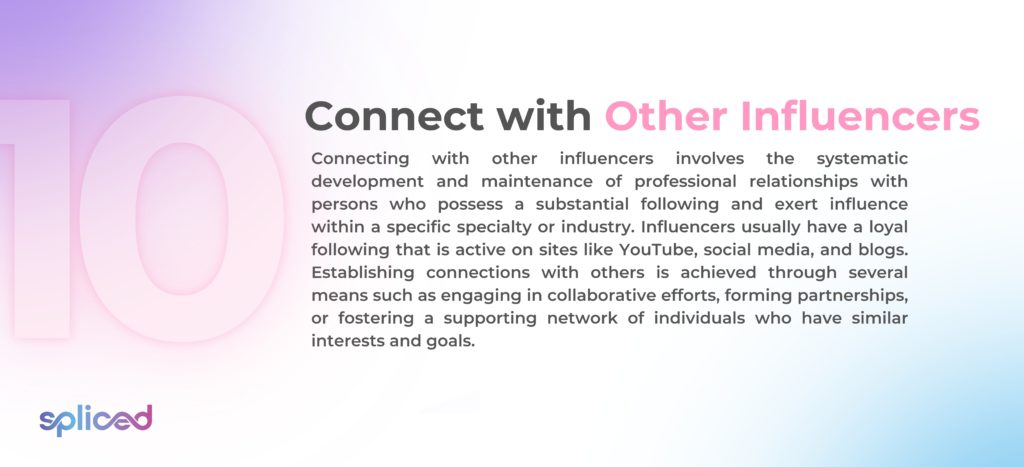
10. Connect with Other Influencers
Connecting with other influencers involves the systematic development and maintenance of professional relationships with persons who possess a substantial following and exert influence within a specific specialty or industry. Influencers usually have a loyal following that is active on sites like YouTube, social media, and blogs. Establishing connections with others is achieved through several means such as engaging in collaborative efforts, forming partnerships, or fostering a supporting network of individuals who have similar interests and goals. The objective is to use the collective influence and knowledge of individuals to increase one’s own digital visibility, exchange valuable perspectives, and engage in collaborative projects or initiatives that provide mutual advantages.
Key aspects of establishing connections with other influencers include the process of recognizing persons whose audience and interests are compatible with one’s own, establishing authentic and mutually advantageous relationships, and seeking out prospects for collaboration or assistance. The method is based on the principles of networking, establishing trust, and offering valuable contributions to fellow members within the influencer community.
The process of establishing connections with other influencers generally starts with proactive outreach and the cultivation of relationships. Authentic and pertinent messages or offers of collaboration are made to influencers via social media, at industry events or conferences, or by simply following and interacting with influencers online. The establishment of strong influencer connections relies on the presence of effective communication and a willingness to engage in the sharing of knowledge, resources, or promotional opportunities.
The importance of connecting with other influencers is in its capacity to enhance one’s outreach, establish reputation, and unlock unique prospects within a specific niche or industry. Establishing connections with influencers enables individuals to leverage their established audience, allowing enhanced visibility and expansion of one’s own online prominence. Collaborating with influencers additionally grants access to their experience, insights, and insider information, increasing the credibility and the value offered to the audience.
The advantages of establishing connections with other influencers include enhanced exposure and credibility, expanded reach to fresh audiences, prospects for collaborative endeavors and mutual promotion, as well as the opportunity for useful exchange of expertise. It has the potential to foster mutually advantageous collaborations that enhance one’s professional or entrepreneurial opportunities.
The disadvantages of connecting with other influencers are important to think about, though. Establishing significant connections is a time-intensive process and does not necessarily provide immediate outcomes. Goals and expectations with other influencers do not always line up, and not every partnership or collaboration is a success.
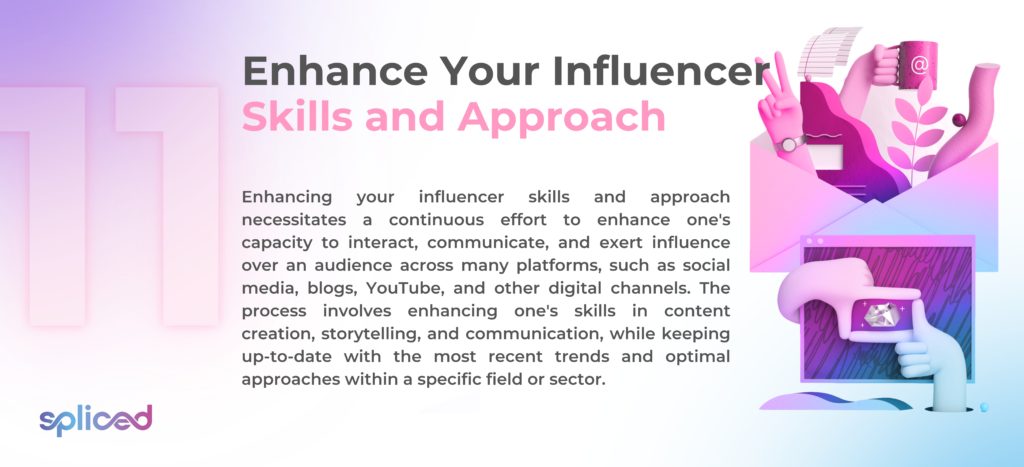
11. Enhance Your Influencer Skills and Approach
Enhancing your influencer skills and approach necessitates a continuous effort to enhance one’s capacity to interact, communicate, and exert influence over an audience across many platforms, such as social media, blogs, YouTube, and other digital channels. The process involves enhancing one’s skills in content creation, storytelling, and communication, while keeping up-to-date with the most recent trends and optimal approaches within a specific field or sector. The objective of enhancing the influencer skills and approach is to build and enhance one’s credibility, status, and influence as an influencer, creating a more genuine connection with the audience and encouraging meaningful engagement and exchanges.
Enhancing the influencer skills and approach is achieved in part by making personal development investments, asking for feedback, keeping up with industry developments, trying out new content formats, and regularly providing the audience with insightful and pertinent information. Continual efforts are made to adjust and expand in accordance with the changing preferences and expectations of one’s audience.
The improvement and development of influencer skills and approach is often achieved by proactive efforts to seek out chances for growth and enhancement. Attending workshops or classes, working with mentors or other influential people, performing audience research, and measuring the efficacy of the content and campaigns are all good ways to get started. Proactively refining one’s skills and adapting one’s approach are crucial in order to maintain influence and effectively connect with one’s audience.
Constant improvement is necessary to be relevant and influential as the influencer market gets more competitive and audience expectations change. Improving one’s knowledge and methods helps in reaching out to more people, creating deeper bonds with them, and making the impact last for years to come. It establishes influencer as a trustworthy and well-respected authority in the field of influencer marketing, which leads to the development of new prospects and partnerships.
There are several advantages associated with improving one’s influencer skills and approach. These include maintaining a competitive edge, cultivating more profound and genuine connections with one’s audience, enhancing one’s influence and credibility, and consistently responding to evolving audience preferences. Becoming a go-to source of information or inspiration in the field of influencer marketing leads to better success in the job or business, particularly if one has a specialization that they specialize in.
The time and work needed for continuous self-improvement, the risk of setbacks or failures, and the requirement to strike a balance between experimentation and preserving a consistent brand identity are some of the potential drawbacks of enhancing the influencer skills and approach.
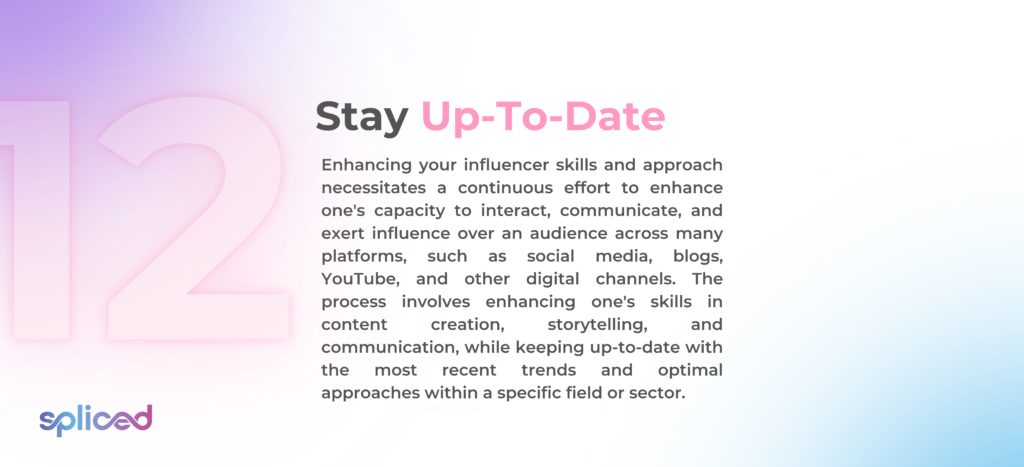
12. Stay Up-To-Date
Staying up-to-date refers to the process of consistently pursuing and obtaining the most recent information, expertise, and advancements within a specific domain or field of interest. Engaging in the continuous observation of news, trends, and other relevant sources of information is important to maintain a high level of knowledge and awareness of the latest advancements and modifications within one’s selected field. Keeping oneself updated is a general strategy to maintain one’s knowledge and abilities current and relevant, and it is not restricted to any one business or setting.
Maintaining current knowledge requires a dedication to lifelong learning, access to reliable information sources, and frequent updating of one’s knowledge base. It necessitates being proactive in obtaining information and being open to changing and growing as a result of fresh perspectives and advancements.
Staying up-to-date involves dedicating time and energy to actively engage with diverse sources of information and news. Engaging in a variety of online activities such as participating in industry-specific communities or forums, articles, attending seminars, conferences, reading books, research papers, webinars, and following industry-specific blogs, websites, and social media accounts are all viable approaches. The process is characterized by ongoing learning and the incorporation of newly acquired information into one’s existing understanding and behaviors.
The contemporary world is characterized by rapid evolution and fast pace, making it important to stay up-to-date. The practice guarantees that individuals and professionals maintain a competitive edge, stay up-to-date, and demonstrate effectiveness in their respective industries. Having a comprehensive understanding of several subjects enables individuals to make more informed decisions, recognize new prospects, and adeptly respond to alterations or disturbances. Remaining current with the latest developments cultivates personal and professional advancement, resulting in enhanced competence and adaptability.
There are several advantages associated with staying up-to-date. These include the enhancement of decision-making capabilities, higher flexibility to changing circumstances, improved problem-solving skills, and the attainment of a competitive edge in both personal and professional domains. It allows influencers to become more educated and engaged members of society who make meaningful contributions locally and globally.
Staying up-to-date presents certain difficulties, such as the time and effort needed to continually gather and assimilate new information. The experience of overwhelm arises when an individual works to absorb an excessive amount of knowledge, resulting in the manifestation of information fatigue or burnout. Differentiating credible sources from untrustworthy ones poses a difficulty, potentially compromising the quality of the information obtained.
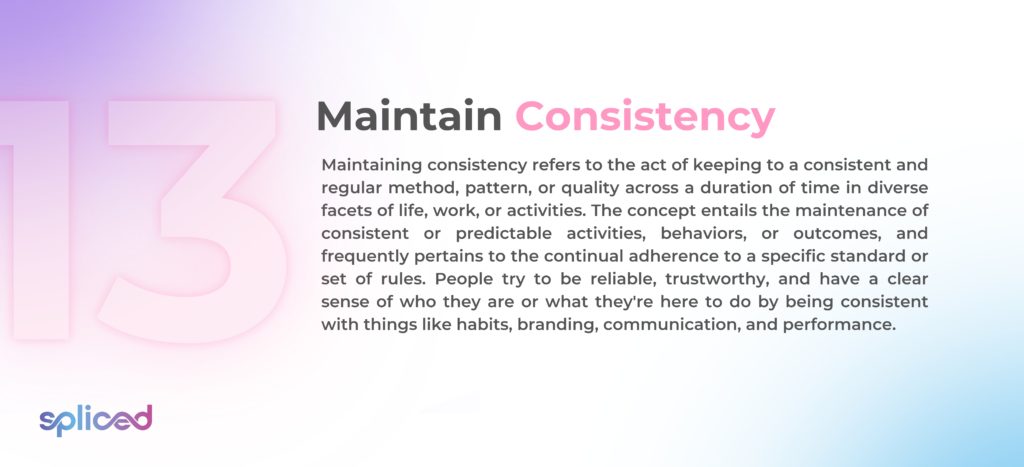
13. Maintain Consistency
Maintaining consistency refers to the act of keeping to a consistent and regular method, pattern, or quality across a duration of time in diverse facets of life, work, or activities. The concept entails the maintenance of consistent or predictable activities, behaviors, or outcomes, and frequently pertains to the continual adherence to a specific standard or set of rules. People try to be reliable, trustworthy, and have a clear sense of who they are or what they’re here to do by being consistent with things like habits, branding, communication, and performance.
Maintaining consistency comprises several essential components, including the establishment of specific expectations, compliance to predetermined standards or rules, and the avoidance of sudden or frequent changes from known patterns. It necessitates a dedication to consistency and predictability in actions, attitudes, or results.
Establishing a system of norms, regulations, or procedures that control a certain aspect of life, work, or activity is how consistency is maintained. Individuals or organizations conscientiously comply with these principles in order to ensure that their actions or outcomes are in accordance with the defined standards. The concept of consistency frequently entails the continuous monitoring of behavior, exercising self-discipline, and demonstrating a readiness to refrain from unplanned changes or alternatives from established patterns.
The importance of maintaining consistency lies in its capacity to encourage trust, dependability, and credibility across many contexts. The development of consistent acts and behaviors is seen as a significant factor in establishing predictability and stability, attributes that have great importance in the areas of human relationships, business encounters, and brand recognition. It promotes self-control and tenacity, which help people and organizations reach long-term objectives and keep a strong sense of identity and purpose.
There are several advantages associated with the practice of keeping consistency. These include the development of trust and credibility, the attainment of long-term objectives, the establishment of a unique identity for the brand, and the enhancement of personal or professional discipline. Consistency contributes to enhanced process efficiency and improved decision-making by establishing a dependable framework for assessing outcomes and implementing enhancements.
Maintaining consistency is hard because routines tend to become boring or rigid, people don’t like change, and influencers have to find a balance between being consistent and being able to adapt in changing settings.
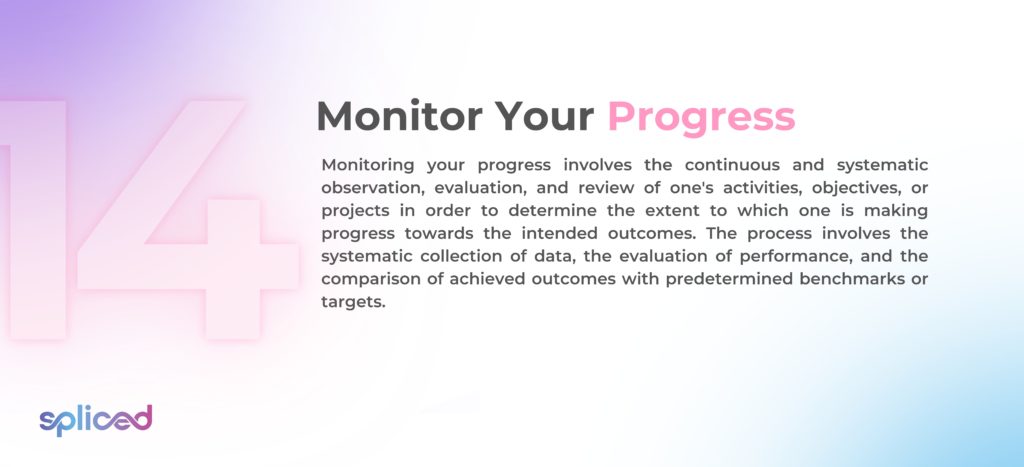
14. Monitor Your Progress
Monitoring your progress involves the continuous and systematic observation, evaluation, and review of one’s activities, objectives, or projects in order to determine the extent to which one is making progress towards the intended outcomes. The process involves the systematic collection of data, the evaluation of performance, and the comparison of achieved outcomes with predetermined benchmarks or targets. The primary objective of progress monitoring is to acquire valuable insights into the efficacy of current strategies, areas requiring enhancement, and the potential need for adjustments to ensure the continued alignment with one’s goals or objectives.
Monitoring progress encompasses several essential components, including the setting of clear and measurable goals, the gathering of important data and metrics, the examination of trends and patterns, and the use of the information to make well-informed judgments and implement necessary remedial measures. The process is characterized by its dynamic and iterative nature, necessitating ongoing attention and a steadfast dedication to continual enhancement.
The process of monitoring progress involves the establishment of a structured framework for the collection and analysis of data that is in accordance with the particular intends or objectives at hand. The process involves establishing key performance indicators (KPIs), outlining success criteria, and putting in place systems and procedures to monitor data. Frequently evaluating the dataset and contrasting it with predetermined objectives enables one to accurately evaluate their progress and make well-informed decisions on the continuation of current tactics, adjustment of approaches, or establishment of new goals.
The use of monitoring progress tools helps the establishment of responsibility, transparency, and knowledge development within personal, professional, and project-related settings. Monitoring the progress lets influencers spot early warning signs for potential problems, enjoy the successes, and make any needed course changes. It helps in keeping influencer goal-focused, evaluating the performance of the tactics, and eventually raising the odds of success.
The advantages of monitoring progress encompass heightened responsibility, the capacity to detect and resolve concerns at an early stage, enhanced decision-making capabilities, and the ability to adapt and adjust tactics for improved outcomes. It creates a feeling of fulfillment as one monitors their advancement towards their objectives.
The amount of work and time needed for data collection and analysis, the risk of dissatisfaction if progress is slower than anticipated, and the requirement for discipline and consistency to sustain the monitoring process over time are some of the difficulties that arise when monitoring progress.
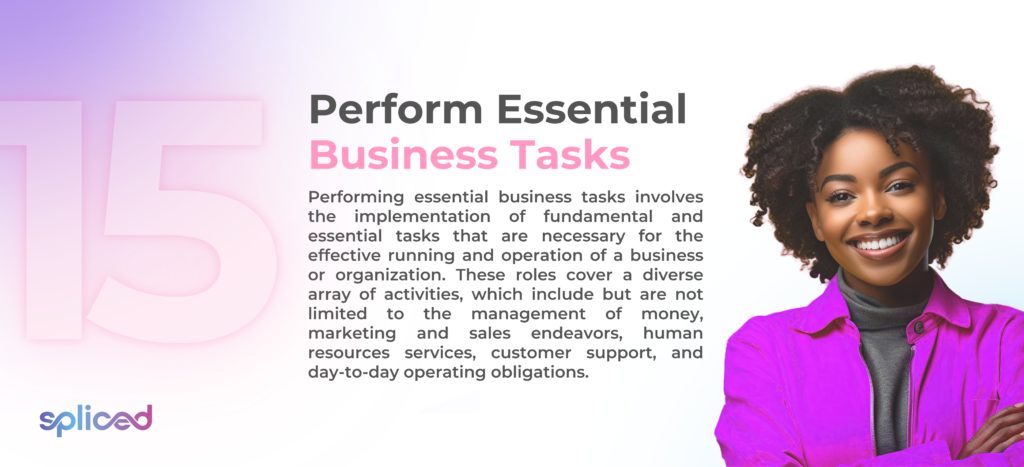
15. Perform Essential Business Tasks
Performing essential business tasks involves the implementation of fundamental and essential tasks that are necessary for the effective running and operation of a business or organization. These roles cover a diverse array of activities, which include but are not limited to the management of money, marketing and sales endeavors, human resources services, customer support, and day-to-day operating obligations. These responsibilities are crucial because they directly support the viability, expansion, and success of the company by making sure it runs smoothly, achieves its objectives, and carries out its duties.
Effective planning, organization, and execution of crucial activities, often in the framework of the company’s strategic goals and operational priorities, are crucial components of carrying out important business tasks. These duties are commonly repetitive in nature and necessitate continuous attention and oversight.
Completing necessary business tasks requires that each important function inside an organization have distinct roles, procedures, and processes. Establishing standard operating procedures, hiring trained workers, using the right technology and tools, and making sure that resources are used efficiently to complete these tasks are some of the things that are needed. The consistent monitoring and evaluation of task performance are essential components in the identification of opportunities for improvement and the maintenance of operational excellence.
A profitable business is built on these activities, which are also necessary to meet long- and short-term objectives. The effective completion of necessary duties guarantees the optimal distribution of resources, financial steadiness, adherence to legal and regulatory obligations, customer contentment, and the general longevity of the organization. Inadequate execution of these activities leads to economic instability, suboptimal operational performance, and adverse consequences for the organization’s reputation and prospects for expansion.
There are several advantages associated with performing essential business tasks. These include the ability to uphold financial stability, adhere to legal and compliance obligations, cultivate consumer trust, and facilitate sustainable corporate expansion. The proficient implementation of these jobs improves operational efficacy and helps to the general success and durability of the business.
The completion of crucial business activities, however, comes with drawbacks, such as the likelihood of higher operational costs, administrative demands, and the requirement for efficient resource management. Neglecting or ignoring these responsibilities results in a number of difficulties and negative impacts on the company.
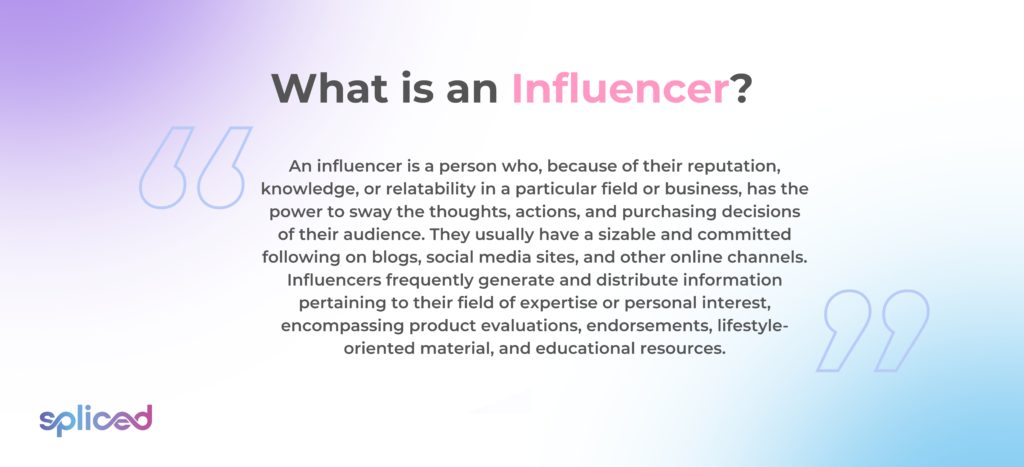
What is an Influencer?
An influencer is a person who, because of their reputation, knowledge, or relatability in a particular field or business, has the power to sway the thoughts, actions, and purchasing decisions of their audience. They usually have a sizable and committed following on blogs, social media sites, and other online channels. Influencers frequently generate and distribute information pertaining to their field of expertise or personal interest, encompassing product evaluations, endorsements, lifestyle-oriented material, and educational resources. The power of individuals in the realm of social media arises from their perceived genuineness, expertise, and the establishment of trust with their followers. They become highly sought-after collaborators for companies and marketers seeking to effectively connect with and captivate a certain target audience.
Influencers are important in social media and digital marketing because they change the opinions and decisions of customers. They use their well-established digital presence and strong relationship with their audience to endorse products, services, or causes, frequently through sponsored content or partnerships with sponsors. Influencer marketing has emerged as a popular approach for companies looking to connect with their target audiences in a genuine way by taking advantage of the relationship and trust that influencers have built with their following.
The assessment of influencers’ achievements encompasses not solely their number of followers, but their levels of interaction, the quality of their content, and their proficiency in effectively conveying messages that correspond with their brand or niche. Influencers bridge the gap between advertising and real, tailored suggestions in the digital age by acting as reliable middlemen between brands and customers.
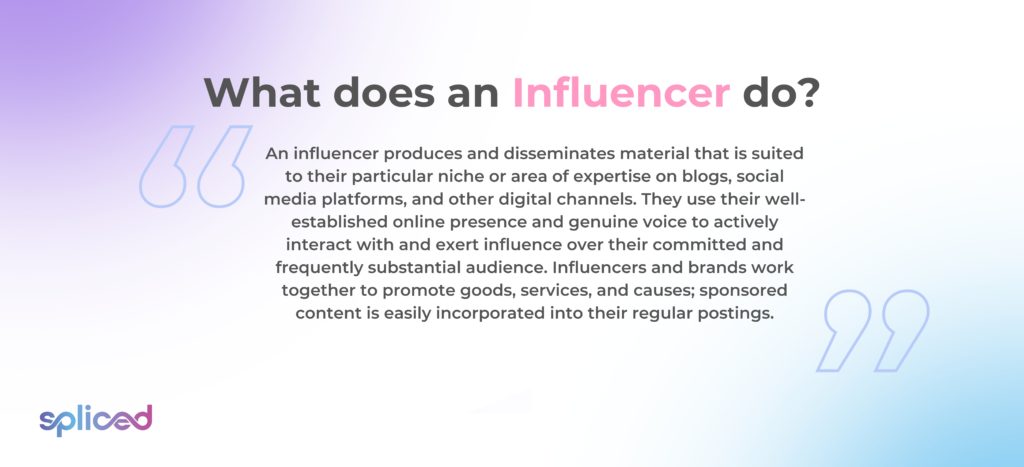
What does an Influencer do?
An influencer produces and disseminates material that is suited to their particular niche or area of expertise on blogs, social media platforms, and other digital channels. They use their well-established online presence and genuine voice to actively interact with and exert influence over their committed and frequently substantial audience. Influencers and brands work together to promote goods, services, and causes; sponsored content is easily incorporated into their regular postings.
The primary objective is to establish genuine connections with the target audience, cultivate trust, and motivate them to take action, like making a purchase, embracing a specific lifestyle, or endorsing a cause. It is something that influencers are able to accomplish by continually producing content of a high quality, interacting with the people who follow them, and delivering value to their audience through their expertise, suggestions, and ability to relate to them.
The impact of influencers comes from their capacity to influence consumer perceptions and decisions through the strategic utilization of the trust and rapport they have established with their followers. Influencers play a crucial role in facilitating communication and collaboration between businesses and customers, establishing themselves as significant allies within the realm of digital marketing.
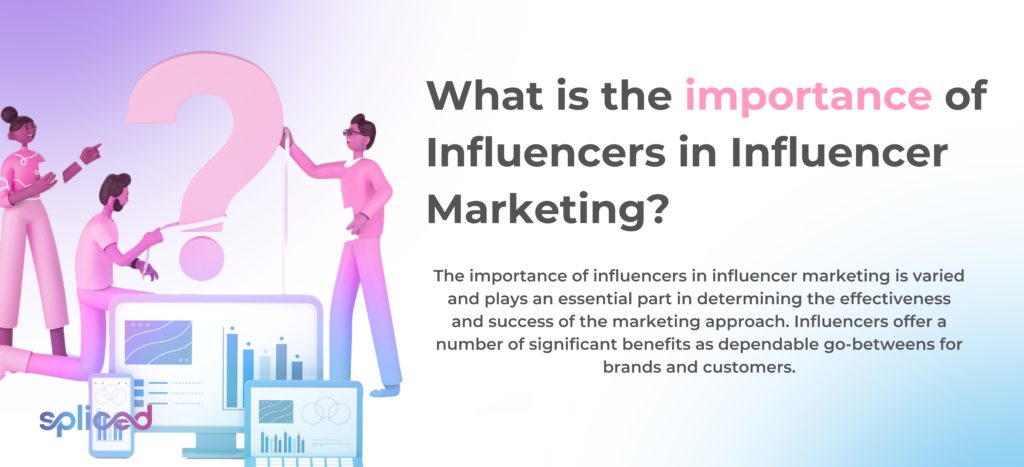
What is the importance of Influencers in Influencer Marketing?
The importance of influencers in influencer marketing is varied and plays an essential part in determining the effectiveness and success of the marketing approach. Influencers offer a number of significant benefits as dependable go-betweens for brands and customers.
Influencers are very persuasive and influential to their devoted followers because, in their particular sector or industry, they have first built reputation and trust. They demonstrate the capacity to genuinely interact with their target audience, establishing a sense of relatability that is frequently absent in conventional advertising.
Influencers possess the ability to effectively engage with extremely precise demographics, enabling marketers to establish more meaningful connections with distinct audience segments. They contribute a personalized element to marketing initiatives, enhancing their level of engagement and memorability. The draw of becoming an influencer in the field of influencer marketing is the chance to use their enthusiasm, experience, and online presence to earn notoriety, partner with brands, monetize their influence, and turn their passion into a job.
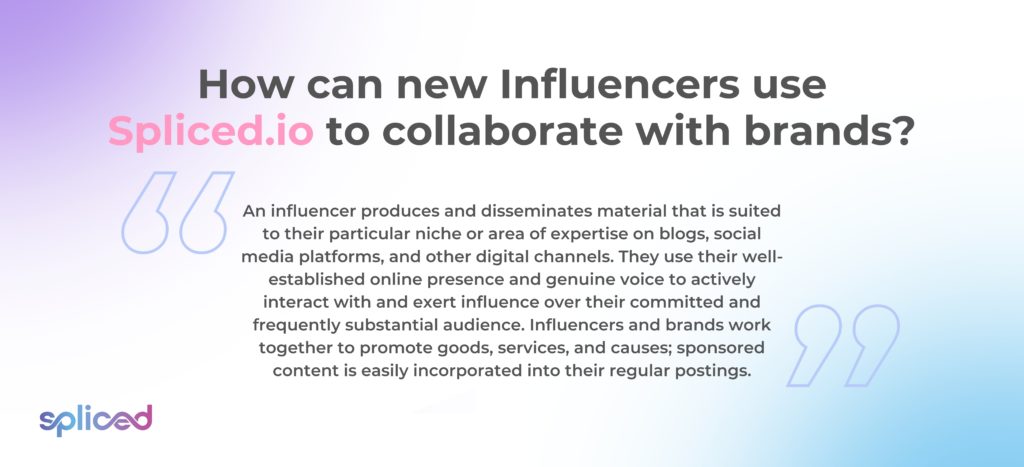
How can new Influencers use Spliced.io to collaborate with brands?
New influencers use Spliced.io to collaborate with the brands by establishing a profile on the platform, wherein they are able to highlight their specialized area of focus, their level of proficiency, and the distinct value they bring forward for brands. Spliced.io offers influencers the opportunity to access a network of brands that are actively seeking relationships with influencers. The service enables influencers to browse through various brands and establish connections with those who are compatible with their content and target audience.
The Spliced.io platform enables influencers to present their portfolio, engagement data, and past collaborations, proving their reputation and appropriateness for brand partnerships. Spliced.io serves as a platform that enables influencers and businesses to engage in open and clear communication and negotiation, hence enhancing the efficiency of the collaboration process.
Spliced.io establishes a secure and protected setting for the processing of payment transactions, guaranteeing equitable remuneration for the services given by influencers. Spliced.io gives new influencers access to a wide range of marketing opportunities, helps them establish their reputation, and helps them launch their influencer career successfully.
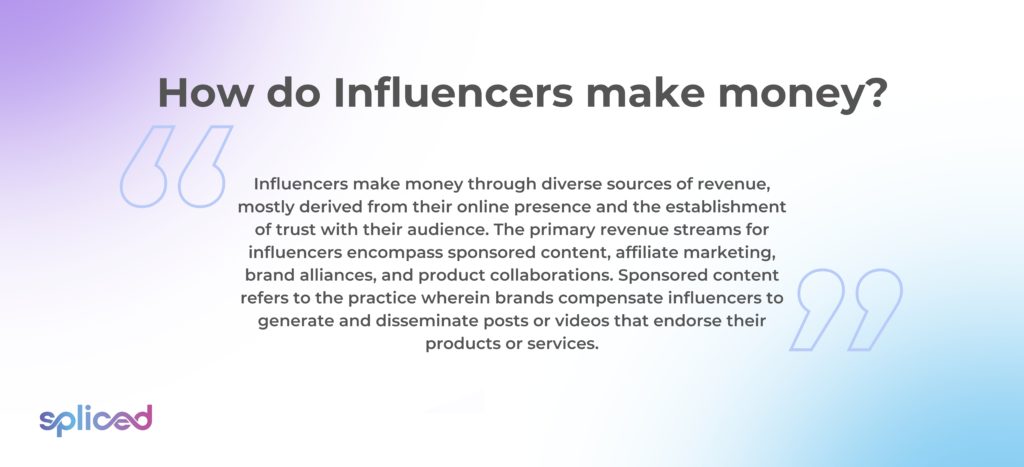
How do Influencers make money?
Influencers make money through diverse sources of revenue, mostly derived from their online presence and the establishment of trust with their audience. The primary revenue streams for influencers encompass sponsored content, affiliate marketing, brand alliances, and product collaborations. Sponsored content refers to the practice wherein brands compensate influencers to generate and disseminate posts or videos that endorse their products or services.
Influencers in affiliate marketing get paid a percentage for generating purchases through original affiliate links. Brand partnerships are extended relationships in which influencers assume the role of brand advocates.
Influencers have the potential to create revenue through many means such as the selling of items, participation in speaking engagements, or the provision of online courses and workshops. The salary of influencers exhibits significant variability, based upon several criteria such as their specific domain, number of followers, rate of participation, and the intricacy of the collaborative endeavor.
Micro-influencers charge as little as a few hundred dollars, while top-tier influencers with millions of followers charge tens of thousands or even millions. The wages of influencers are moreover impacted by their capacity for negotiating and the considered value they provide to brands.
The degree of influence and type of partnership an influencer has has a big impact on how much money they make. Micro-influencers, characterized by their comparatively small yet actively involved follower bases, have the potential to generate income ranging from $100 to $1,000 for each sponsored post or campaign they undertake.
Campaign fees for mid-tier influencers usually range from $1,000 to $10,000. High-profile influencers with millions of followers earn high fees; for a single campaign, they frequently attract prices between $10,000 and several hundred thousand dollars or more.
It’s important to remember that influencers are able to obtain things other than money, like free goods, trips, or the chance to learn about new opportunities. The income of an influencer is ultimately determined by various factors, including their chosen niche, level of knowledge, and the extent to which they provide value through brand collaborations.
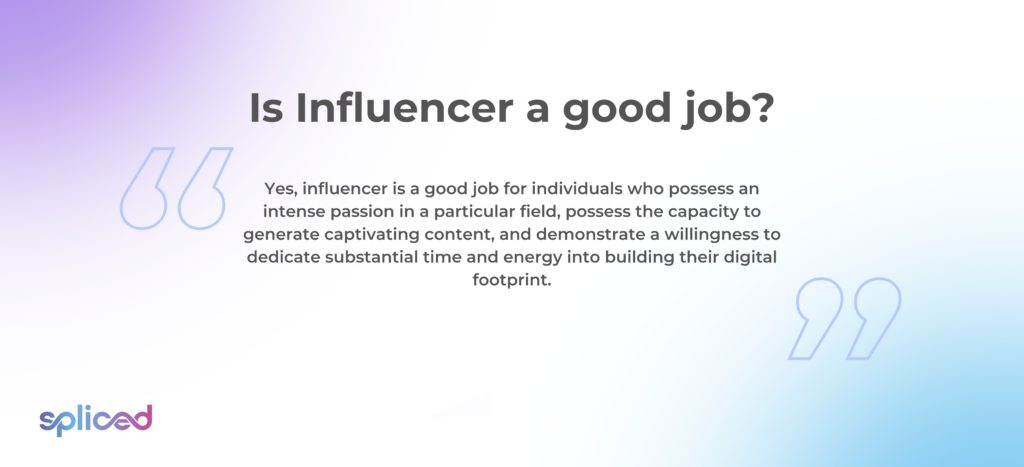
Is Influencer a good job?
Yes, influencer is a good job for individuals who possess an intense passion in a particular field, possess the capacity to generate captivating content, and demonstrate a willingness to dedicate substantial time and energy into building their digital footprint.
Influencers possess the capacity to generate revenue through sponsored partnerships, affiliate marketing, and several other channels of income. They frequently have the freedom to engage in projects pertaining to subjects that ignite their personal enthusiasm.
The field of influencer marketing is experiencing significant growth, with accomplished influencers effectively utilizing their influence to establish collaborative relationships with businesses, resulting in a satisfying and financially rewarding profession.
Being an influencer does have its difficulties. The process of establishing a significant following and establishing reputation is time-consuming, and achieving success is not assured. There is a lot of competition among influencers, and it is hard to keep making content and keeping the audience interested.
Influencers need to manage their money and make plans for an eventuality of financial instability because income fluctuates. The viability of pursuing a career as an influencer is based upon an individual’s aspirations, commitment, and capacity to handle the unique challenges present in the influencer sector.
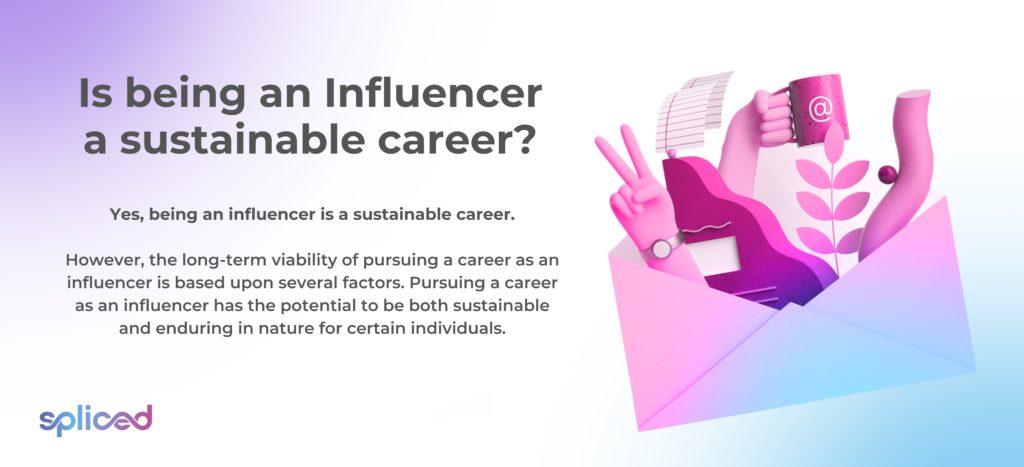
Is being an Influencer a sustainable career?
Yes, being an influencer is a sustainable career. However, the long-term viability of pursuing a career as an influencer is based upon several factors. Pursuing a career as an influencer has the potential to be both sustainable and enduring in nature for certain individuals.
Influencers that have achieved success by building a dedicated and actively involved following, establishing several sources of income, and effectively adapting to change within their respective industries frequently attain long-term viability in their professional endeavors. They are able to establish profitable brand alliances, hold onto their power over time, and even change their content to reflect changing trends and consumer preferences.
It’s crucial to understand that the influencer market is competitive and changing. A considerable number of individuals seeking to become influencers fails to attain the required level of accomplishment necessary for sustained viability in the long run. An influencer’s career path is impacted by variables like altered audience preferences, platform algorithm modifications, and heightened competition.
The significance of sustainability is based upon the effectiveness of financial planning, given the potential variability and unpredictability of revenue. Influencer sustainability requires diversifying sources of income, setting aside money, and making long-term plans.
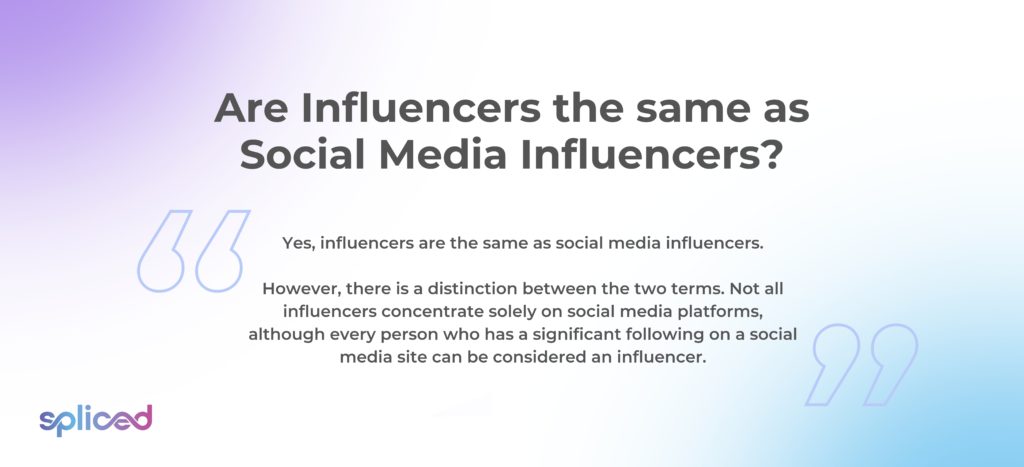
Are Influencers the same as Social Media Influencers?
Yes, influencers are the same as social media influencers. However, there is a distinction between the two terms. Not all influencers concentrate solely on social media platforms, although every person who has a significant following on a social media site can be considered an influencer.
There is a broader definition of “influencers” that includes people who have a lot of credibility and influence in many areas, such as social media. They use a variety of platforms, including blogs, YouTube, podcasts, public speaking, and more, to influence the views and judgments of their audience.
Social media influencers use their popularity solely on social media sites like Instagram, YouTube, TikTok, and Twitter to interact with their followers and push content, products, or services. Social media influencers utilize these platforms as their principal channels for communication and dissemination of content.
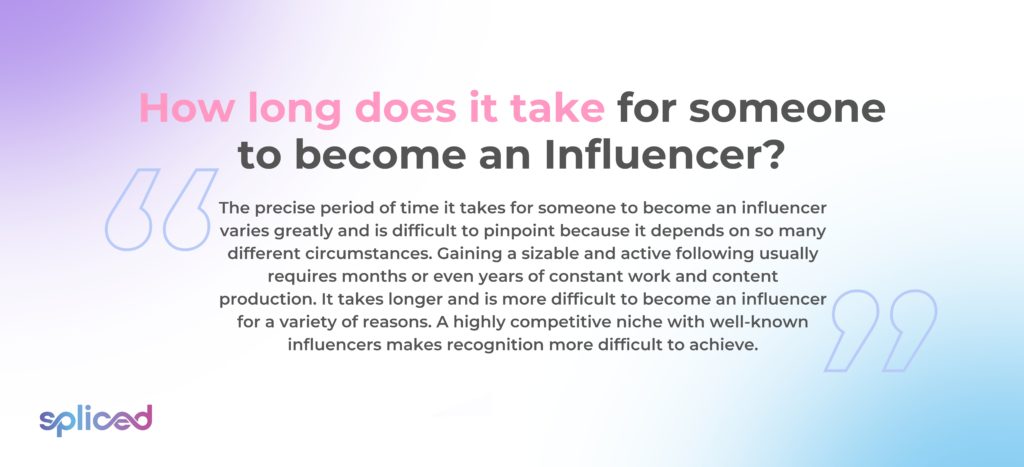
How long does it take for someone to become an Influencer?
The precise period of time it takes for someone to become an influencer varies greatly and is difficult to pinpoint because it depends on so many different circumstances. Gaining a sizable and active following usually requires months or even years of constant work and content production. It takes longer and is more difficult to become an influencer for a variety of reasons. A highly competitive niche with well-known influencers makes recognition more difficult to achieve.
Influencers frequently have slow growth phases, so patience, consistency in publishing, and high-quality content are essential. The length of time is additionally influenced by establishing brand partnerships, comprehending the target audience, networking and forming relationships within the niche, and adjusting to platform changes. Influencer success ultimately comes down to a variety of elements and the capacity to adjust to the particular difficulties faced by the sector.
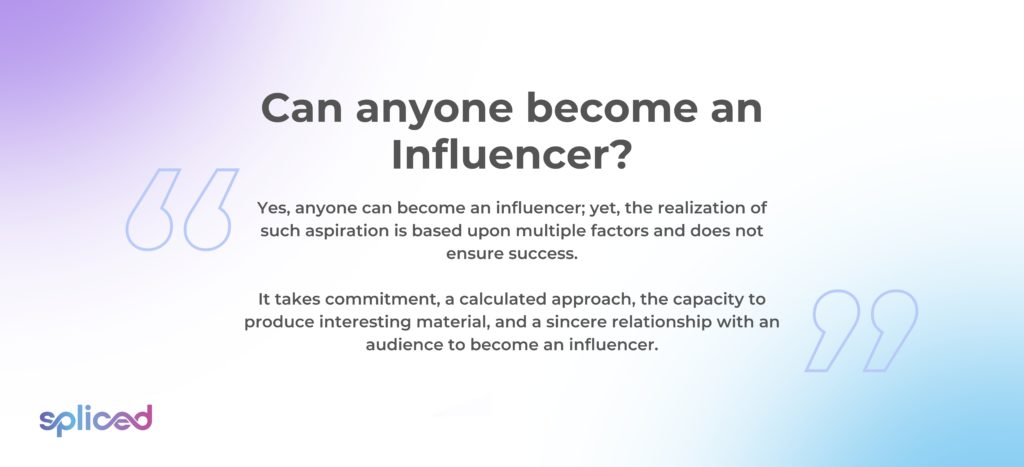
Can anyone become an Influencer?
Yes, anyone can become an influencer; yet, the realization of such aspiration is based upon multiple factors and does not ensure success. It takes commitment, a calculated approach, the capacity to produce interesting material, and a sincere relationship with an audience to become an influencer.
Finding a niche or area of expertise, generating content regularly that speaks to that niche, and interacting with followers are all part of it as well. There are many things that determine who becomes an influencer. These include how competitive the niche is, the quality of the content, the ability to adapt, and the ability to stand out in a crowded digital world.
A person’s journey to becoming an influencer is influenced by timing and chance. It is critical to approach goals of being an influencer with reasonable expectations and a willingness to put in the time and work necessary to establish credibility and a presence in the targeted niche.
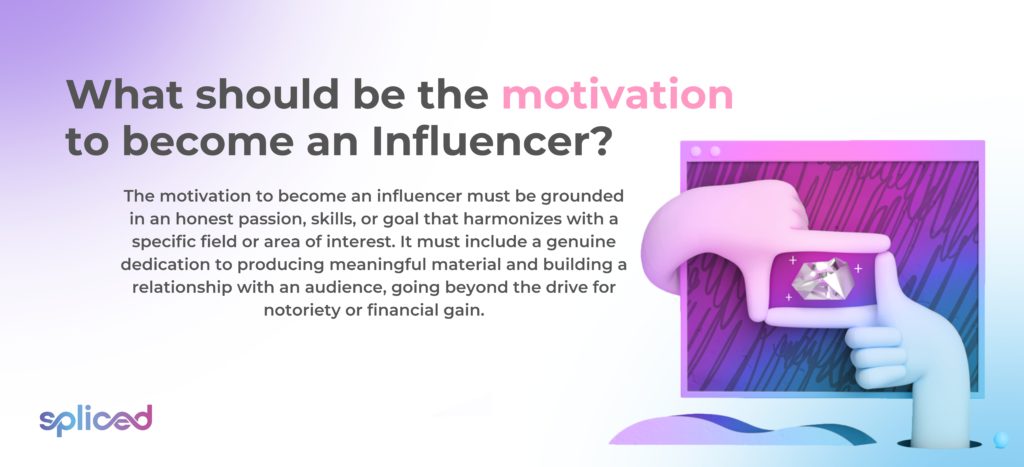
What should be the motivation to become an Influencer?
The motivation to become an influencer must be grounded in an honest passion, skills, or goal that harmonizes with a specific field or area of interest. It must include a genuine dedication to producing meaningful material and building a relationship with an audience, going beyond the drive for notoriety or financial gain.
The motivation of successful influencers frequently stems from their deep passion for a certain subject, their aspiration to disseminate information or personal experiences, or their objective to inspire and have a beneficial impact on others. The desire to use one’s influence for social concerns, the joy of creative expression, or the chance to form a community all serve as sources of inspiration. The primary and strongest reason to pursue a career as an influencer lies in the presence of realness, a clear sense of purpose, and a sincere bond with both the content produced and the audience it caters to.
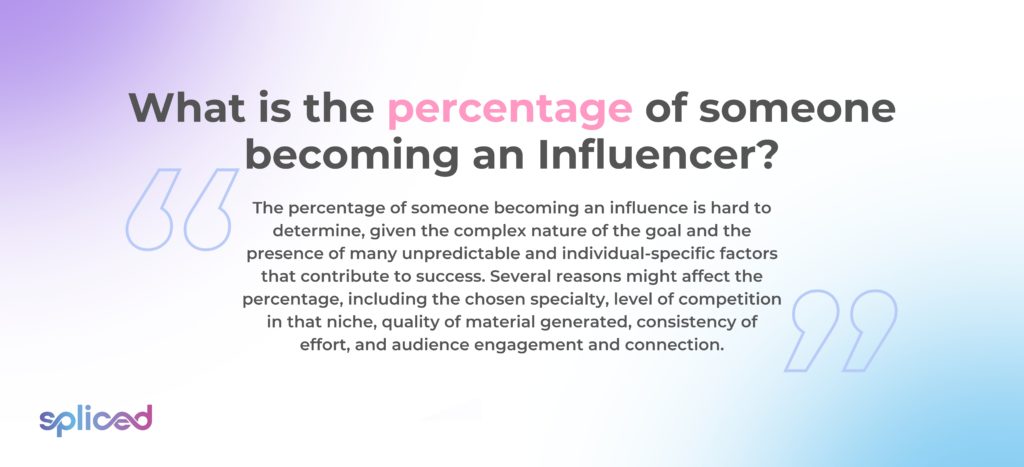
What is the percentage of someone becoming an Influencer?
The percentage of someone becoming an influence is hard to determine, given the complex nature of the goal and the presence of many unpredictable and individual-specific factors that contribute to success. Several reasons might affect the percentage, including the chosen specialty, level of competition in that niche, quality of material generated, consistency of effort, and audience engagement and connection.
Not everyone who wants to be an influencer is going to succeed in doing so, even though the influencer market is still expanding. Achieving success frequently necessitates the integration of commitment, creativity, flexibility, and some degree of fortunate circumstances. It’s important to remember that people are able to boost their chances of becoming successful influencers over time if they choose the right area, use the right strategy, and work hard to build a real online presence.
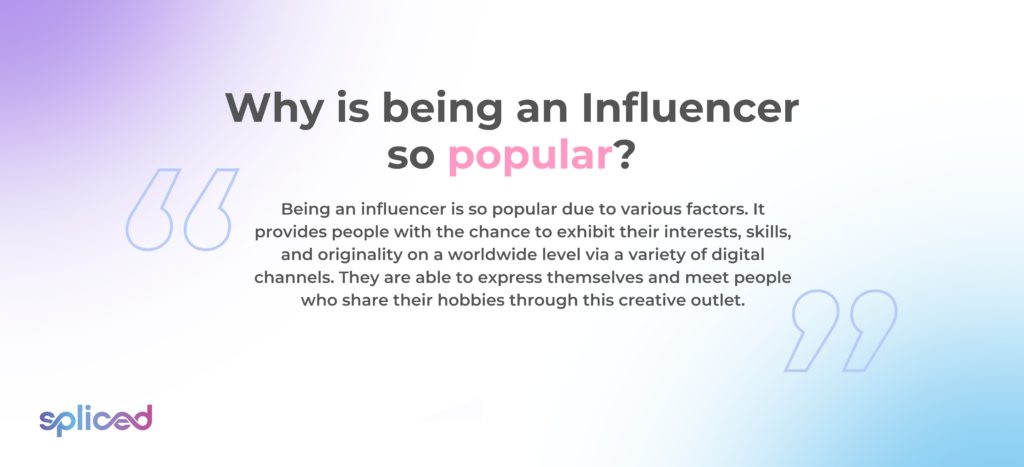
Why is being an Influencer so popular?
Being an influencer is so popular due to various factors. Firstly, it provides people with the chance to exhibit their interests, skills, and originality on a worldwide level via a variety of digital channels. They are able to express themselves and meet people who share their hobbies through this creative outlet.
Influencers have access to an amount of control and flexibility in their job that is frequently not accessible in traditional careers, and they are able to create a personal brand. Influencer marketing has become a desirable professional path due to the potential of financial gain through affiliate marketing, brand collaborations, and other revenue streams.
Influencers frequently derive a sense of satisfaction from their capacity to motivate and influence their audience in a positive manner, be it through giving guidance, recommending products, or advocating societal issues. The appeal of becoming an influencer is attributed to the combination of creative expression, personal branding, financial prospects, and the capacity to make a significant impact on the lives of their audience.
